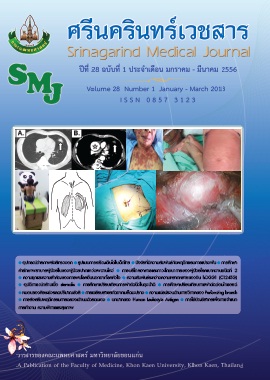Dietary Intake and Nutritional Status of Type 2 Diabetic Patients at Mahosot Hospital, Vientiane Capital City, Lao PDR
Keywords:
type 2 diabetes, food consumption, nutritional statusAbstract
Background and objective : Every year there is an increasing number of type 2 diabetic patients attending Mahosot Hospital. Dietary intake of diabetic patients is an important factor for controlling of blood glucose levels. The aim of this study was to investigate the dietary intake and nutritional status of type 2 diabetic patients attending the diabetic clinic at Mahosot Hospital in Vientiane Capital City, Lao PDR.
Methods: The 200 participants in this cross-sectional descriptive study were the type 2 diabetic patients attending the outpatient diabetic clinic at Mahosot Hospital. A food frequency questionnaire and a 24-hour dietary recall were used to obtain information about dietary intake. Energy and nutrient intakes were analyzed using the INMUCAL-N version 2 program. Body mass index (BMI) and waist circumference were used to assess nutritional status.
Results: Sixty percent of the diabetic patients were female, and the mean age of subjects was 58 years (SD=9.2). The subjects had high fasting blood glucose level (130-180 mg/dl) by 42.0%, very high level (>180 mg/dl) by 32.5%. Almost all the subjects daily ate rice (94%) vegetables (96.5%) and fish (78.5%). Just over two-thirds (67.5%) did not consume fatty meat, but about half of the subjects ate fried food and animal organs 1-3 times per week. Sweet and sour fruits were eaten daily by 43.5%, and 11% drank coffee or tea every day. The median daily calorie intake represented 72.0% of the recommended calorie requirement, and the median daily protein intake was 89.7% of the recommended protein requirement. Energy distribution from carbohydrate, protein and fat was 69.8, 17.3 and 12.0% of total energy intake, respectively. Cholesterol were consumed about 122 grams per day. The subjects were obese (BMI ≥25 kg/m2) by 53.5%, and abdominal obesity was found in 66.7% of females and 45% of males.
Conclusions: The type 2 diabetic patients frequently ate rice, fish and vegetables on a daily basis, but about half of patients were obese. The patients’ main energy intake came from carbohydrates, and their mean fasting blood sugar was often well-above normal.
Keyword: type 2 diabetes, food consumption, nutritional status




